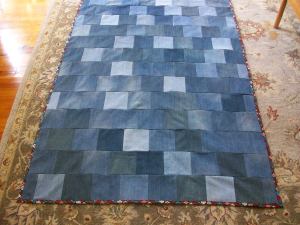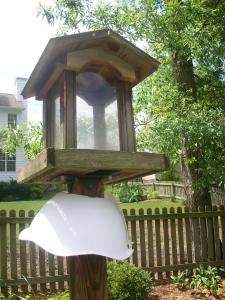
The fruits of our labors.
It was time. I felt guilty every time I peeled a bag of potatoes and put the peels in the trash. We had done a good job cutting down on our family’s weekly trash by recycling, but we generated a significant amount of compostable waste every week.
I live in suburbia with a decent-sized yard, but it butts up to neighbors on three sides. It really isn’t the right situation for an open compost pile. I didn’t want to offend anyone with the appearance and possible smell of an open bin, and I was worried about attracting raccoons or rodents—or snakes! I researched manufactured compost bins and fell in love with a few models of rotating and tumbling compost bins that claim to speed the decomposition time and screen the finished compost. I did not fall in love with the price tags. The cost was outside my budget for this project, and it seemed contradictory to me to spend that much money on something to make us more efficient with our trash.
In my search for a simple, economical way to compost, I came across a few descriptions of compost bins made from 30-gallon plastic garbage cans. I had an extra garbage can, so a few months ago I used an electric drill to create air holes in the sides of the can. (I drilled eight rows of holes about four inches apart.) For easy access, I placed the new compost bin near our back porch. I set aside a two-quart plastic container with a tight-fitting lid and started filling it with kitchen waste, using the guidelines below from our town website.
What to Put in a Compost Pile
Almost all organic food scraps and yard waste scraps can be added to a compost pile with good results. The smaller the pieces are when they are added to your compost pile, the faster they will decompose.
- leaves, grass clippings, plant stalks, vines, twigs, and branches
- fruit and vegetable scraps
- coffee grounds
- eggshells and nutshells
- hair clippings, feathers, straw
- dryer lint, moisten first
What Not to Put in a Compost Pile
Materials should NOT be composted if they promote disease, cause odors, attract pests, or create other nuisances.
- meat, fish, poultry, dairy products
- foods containing animal fats
- human/pet (dog, cat)/bird feces
- weeds with developed seed heads
- plants infected with or highly susceptible to disease, such as roses and peonies
- charcoal ash, contains sulfur dioxide which can harm plants

DIY compost bin.
I emptied the plastic container into the aerated garbage can a few times, and in about 10 days I was rewarded with—the largest colony of flies I have ever seen. So I moved the compost bin to a location a bit further from the house, found the flyswatter to handle the flies that followed me into the house, and I went back to the drawing board to learn more about the balance of wet and dry and green and brown in the compost world. Evidently, adding only kitchen scraps (green) to the compost bin creates a slimy mess, so I needed to balance it out with layers of finely shredded newspapers and brown leaves. I also added about a cup of lime to keep down the flies and aid in decomposition.
A few months later, I can’t say that I have really figured out the science of composting. I can say that we have reduced our trash by quite a bit–and we have generated some compost. I still have to remind the kids to put the banana peels and apple cores in the compost bucket, but my husband is on board and regularly treks the scraps to the compost bin. (I think he is also worried that the scraps will draw critters to the porch. It hasn’t been a big problem, but the occasional squirrel can open the bin. A few days ago I watched a small squirrel nibble every little bit of red fruit off of the strawberry hulls I had placed in the bucket. I didn’t have the heart to scare the little guy away.)

Cage for curing compost.
I am not sure that the trash-can method allows enough air to get to the compost. The contents of the bin were decomposing but not looking like fine soil, so I dumped the contents of the bin into a circle of garden fencing and it has finished up nicely. I will be adding the compost to the soil in my garden beds, and I am repeating the process—fill the compost bin with layers of green and brown stuff and turn it occasionally until it is sludgy, and then dump the bin contents into a pile to finish up. My low-tech compost solution seems to be doing the trick for my family at the moment.













